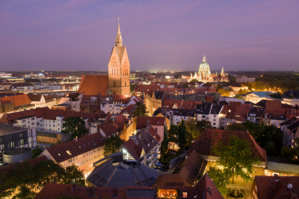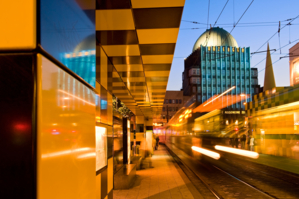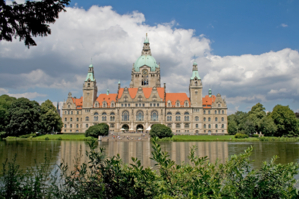Press Information
Hannover - Facts and figures
Here you can find and download press information.
Geographical situation
Hannover, capital city of the Federal State of Lower Saxony, is an important, centrally situated industrial and trade fair location in the heart of Europe. The city lies on the River Leine, where the North German lowlands gradually give way to the mountainous region of Lower Saxony. In the south-west, the city borders on the foothills of the Weserbergland district with its fertile loess soil. Its convenient location on the intersection between traditionally busy traffic corridors from north to south and east to west played a major part in Hannover’s development from medieval village to modern metropolis.
Structure
The city itself forms the core of Hannover Region, an association of 21 municipalities. Founded on 1 November 2001, the establishment of Hannover Region has meanwhile earned nationwide respect as a pioneering political and administrative move and a milestone in the efficient provision of public services for the population.
The city of Hannover itself consists of 51 different neighbourhoods. One of the prominent features of the cityscape is the high proportion of green spaces, including Eilenriede, the largest city forest in Europe, which has almost twice the size of the Central Park in New York. With green spaces accounting for 11 per cent of the total area of approx. 200 square kilometres, Hannover has rightfully earned the title of “Green City”.
 © HMTG / Kirchner
© HMTG / Kirchner For press purposes:image in printable resolution (300dpi)Copyright: HMTG
Infrastructure
The infrastructure projects undertaken in the run-up to EXPO 2000 played a key role in providing Hannover with highly efficient transport networks with first-rate national and international connections. The frequent services operated by the local public transport companies üstra, Regio-Bus as well as suburban trains of DB provide excellent links for the city districts and surrounding towns. Hannover Region is one of the reference regions that are frequently named in connection with forward-looking urban mobility concepts.
Thanks to its central location in the heart of Europe, Hannover Region is ideally integrated in the major European transport connections. This is where the A7 motorway (Munich-Hamburg) and A2 motorway (Ruhr Area-Berlin) intersect. The Deutsche Bahn ICE network also ensures fast rail links to and from all major conurbations. Hannover Airport offers direct flights to more than 100 destinations, and the Mittelland Canal, the longest manmade waterway in Germany, connects Hannover with the major seaports and inland ports on the Continent.
 © HMTG / Martin Kirchner
© HMTG / Martin Kirchner For press purposes:image in printable resolution (300dpi)Copyright: HMTG / Martin Kirchner
Multicultural profile
Hannover has extensive experience as a venue for international events. Many world-famous fairs, including the flagship Hannover Messe, attract trade visitors from all over the world year after year. Hannover is also a respected university location. Leibniz University, whose technical faculties in particular attract students from all over the globe, makes a major contribution to the city’s multicultural atmosphere. Hannover’s image of itself as a multicultural venue is also evident from various events and festivals, such as the nationally acclaimed World Music Festival “MASALA”, which draws musicians from all over the world to the city every year.
Lifestyle
Hannover Region offers an excellent quality of life and appeals to people of all age groups. In addition to extensive green spaces, it also boasts excellent shopping amenities within easy reach, a bustling club and nightlife scene as well as a wide selection of recreational areas in and around the city. Hannover is surrounded by beautiful countryside which is ideal for diverse pursuits ranging from water sports (Lake Steinhude) to hiking and nature study (Deister Hills).
Administrative and government structure
Since 1 November 2001, Hannover Region has been a municipal association consisting of 21 municipalities. Although the city relinquished its status of independently administered city as part of the reform, it has retained the same rights as independent cities. In the state capital, a directly elected, full-time mayor is head of the city council and representative of the city. The city council comprises 64 councillors and the mayor. Hannover Region is governed by a regional assembly, which consists of 85 members who are elected for a term of five years in local elections. These members also include the Regional President, who serves for a term of eight years.
 © HMTG
© HMTG Download:printable resolution (300dpi)Copyright: HMTG
Facts andfigures (Region)
• Area: 2.290 km² (nearly twice the size of the Saarland)
• Population: 1.1 million
• Population density: 496 inhabitants/km²
Economy
Hannover is home to various global industrial players which have evolved from traditional businesses dating back to the 19th century. Some of the main industrial names include automobile supplier Continental AG, Volkswagen Commercial Vehicles, the vehicle control systems manufacturer WABCO, building machinery manufacturer Komatsu Hanomag, Varta battery works (now Johnson Controls) and abrasives producer VSM Vereinigte Schmirgel- und Maschinen-Fabriken. These days, Hannover can also claim a flourishing service sector, mainly in the field of tourism, with the TUI Group, as well as numerous actors in the finance and insurance sector, such as Hannover Rück and VHV.
Hannover’s role as a leading international trade fair venue cannot be stressed often enough. Deutsche Messe AG is the largest German trade fair organiser and its exhibition grounds are the largest in the world.

 Deutsch
Deutsch
 English
English
 中文
中文
 Danish
Danish
 Eesti
Eesti
 Español
Español
 Suomi
Suomi
 Français
Français
 Italiano
Italiano
 日本語
日本語
 한국
한국
 Nederlands
Nederlands
 Norge
Norge
 Polski
Polski
 Portugues
Portugues
 Русский
Русский
 Svenska
Svenska
 Türkçe
Türkçe
 العربية
العربية
 Romanesc
Romanesc
 български
български